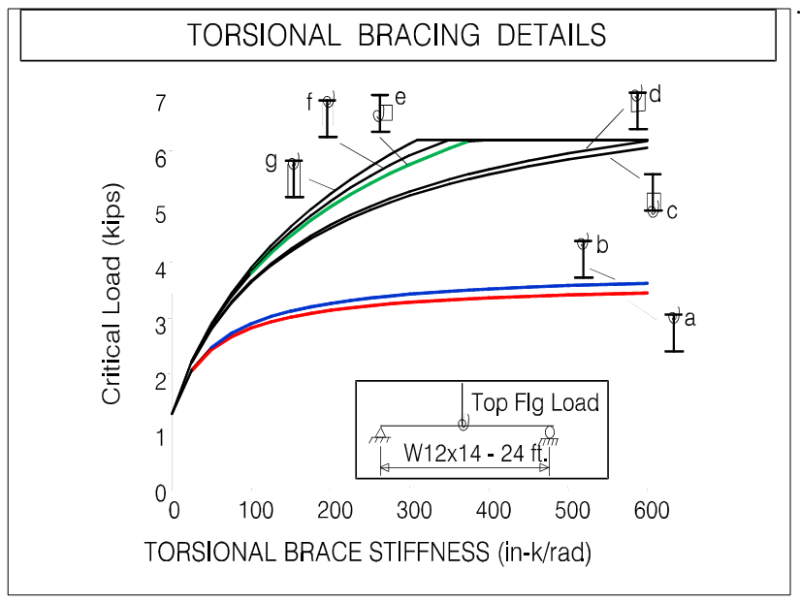What’s the most appropriate way to analyze a continuous steel wide flange beam over steel columns for flexure?
Consider a simple example:
-100 ft. long continuous steel wide flange beam (if there are any splices in the beam consider them CJP, effectively making it continuous. This may be unreasonable in practical applications, but it’s a needed simplification for me to ask my questions below)
-Beam supported on steel columns at 20 ft. O.C.
-Beam’s top flange braced by purlins every 5 ft.
-Beam’s bottom flange not braced by purlins
-Supports uniform gravity loads only
I’ve seen a lot of discussions on inflection points used at brace points in the past, but that AISC doesn’t allow that any more. What is the appropriate way to analyze the strength of this beam? To clarify, I’m not looking for advice on how to provide bracing to the bottom flange, I’m wondering what the proper way is to determine the strength of the beam as is.
Specifically, I have 2 questions:
1. What Cb value should be used? Do I use AISC 360-10 Equation F1-1, or some other equation? If I use F1-1, Do I use quarter points between the columns (as in, MA, MB, and MC would be 5ft. away from eachother), or something else?
2. What Lb value should be used? This seems to get overlooked in many of the discussions I’ve found on this subject. Taking Lb = 100 ft. seems way too unreasonable, the bending strength becomes so small that even a large Cb can’t make up for it. Taking Lb = 20 ft. for the column spacing might be reasonable, but I can’t find anything in the code that suggests you can do this. If you were to use the distance between inflection points for the negative moment you might get an Lb = 10ft.+/-, but this isn’t allowed by code.
To explain why Lb = 100 ft. for the full beam length is unreasonable, another way of looking at it is that if the beam were 200 ft. long (and Lb = 200 ft.) the bending strength would be even further reduced, but common sense tells us that a continuous 100 ft. beam over columns at 20 ft. O.C. should perform similarly to a 200 ft. continuous beam over columns at 20 ft. O.C.
Hopefully you understand where my confusion is coming from. Thanks for any help.
Consider a simple example:
-100 ft. long continuous steel wide flange beam (if there are any splices in the beam consider them CJP, effectively making it continuous. This may be unreasonable in practical applications, but it’s a needed simplification for me to ask my questions below)
-Beam supported on steel columns at 20 ft. O.C.
-Beam’s top flange braced by purlins every 5 ft.
-Beam’s bottom flange not braced by purlins
-Supports uniform gravity loads only
I’ve seen a lot of discussions on inflection points used at brace points in the past, but that AISC doesn’t allow that any more. What is the appropriate way to analyze the strength of this beam? To clarify, I’m not looking for advice on how to provide bracing to the bottom flange, I’m wondering what the proper way is to determine the strength of the beam as is.
Specifically, I have 2 questions:
1. What Cb value should be used? Do I use AISC 360-10 Equation F1-1, or some other equation? If I use F1-1, Do I use quarter points between the columns (as in, MA, MB, and MC would be 5ft. away from eachother), or something else?
2. What Lb value should be used? This seems to get overlooked in many of the discussions I’ve found on this subject. Taking Lb = 100 ft. seems way too unreasonable, the bending strength becomes so small that even a large Cb can’t make up for it. Taking Lb = 20 ft. for the column spacing might be reasonable, but I can’t find anything in the code that suggests you can do this. If you were to use the distance between inflection points for the negative moment you might get an Lb = 10ft.+/-, but this isn’t allowed by code.
To explain why Lb = 100 ft. for the full beam length is unreasonable, another way of looking at it is that if the beam were 200 ft. long (and Lb = 200 ft.) the bending strength would be even further reduced, but common sense tells us that a continuous 100 ft. beam over columns at 20 ft. O.C. should perform similarly to a 200 ft. continuous beam over columns at 20 ft. O.C.
Hopefully you understand where my confusion is coming from. Thanks for any help.

